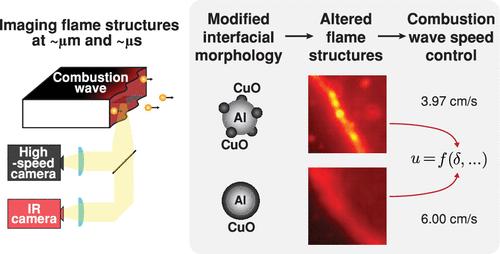当前位置:
X-MOL 学术
›
ACS Appl. Mater. Interfaces
›
论文详情
Our official English website, www.x-mol.net, welcomes your
feedback! (Note: you will need to create a separate account there.)
Microstructural Thermal Zones in Reaction of Nanoenergetics
ACS Applied Materials & Interfaces ( IF 8.3 ) Pub Date : 2024-11-19 , DOI: 10.1021/acsami.4c13603 Benjamin Cha, Anqi Wang, Suyong Kim, Jean-Pierre Hickey, Sili Deng, John Z. Wen
ACS Applied Materials & Interfaces ( IF 8.3 ) Pub Date : 2024-11-19 , DOI: 10.1021/acsami.4c13603 Benjamin Cha, Anqi Wang, Suyong Kim, Jean-Pierre Hickey, Sili Deng, John Z. Wen

|
Despite the potential of nanoenergetics as promising energy sources with high energy densities and fast energy release, our limited ability to predict combustion speeds restricts the utilization of nanoenergetics. Here, we provide a comprehensive analysis of thermal microstructures subject to heterogeneous reactions and propose a new scaling for combustion wave speeds. To control reaction heterogeneity, two different particle interfacial morphologies of physically mixed and core–shell Al/CuO nanoparticles were synthesized. The combustion dynamics and temperature fields were obtained at micrometer-scale resolutions using high-speed and infrared cameras. Experiments showed that the core–shell Al/CuO exhibiting less reaction heterogeneity had a faster wave speed than the physically mixed counterpart, although the measured chemical reaction rates were lower. By employing the thermal structure analysis, we found that the shortened preheat zone and the lengthened reaction zone, attributed to the lower reaction onset temperature and reaction rate, led to the increased wave speed despite the lower reaction rate in the core–shell Al/CuO. From these analyses, we developed a new scaling that describes the combustion wave speeds in nanoenergetics based on intrinsic properties and thermal structures for both morphologies.
中文翻译:

纳米能量学反应中的微结构热区
尽管纳米能量学具有作为具有高能量密度和快速能量释放的有前途的能源的潜力,但我们预测燃烧速度的能力有限,限制了纳米能量学的利用。在这里,我们对受非均相反应影响的热微观结构进行了全面分析,并提出了一种新的燃烧波速度标度。为了控制反应异质性,合成了物理混合和核壳 Al/CuO 纳米颗粒的两种不同颗粒界面形态。燃烧动力学和温度场是使用高速和红外相机以微米级分辨率获得的。实验表明,表现出较少反应异质性的核壳 Al/CuO 比物理混合的核壳 Al/CuO 具有更快的波速,尽管测得的化学反应速率较低。通过采用热结构分析,我们发现,尽管核壳 Al/CuO 中的反应速率较低,但由于反应起始温度和反应速率较低,缩短的预热区和延长的反应区导致波速增加。从这些分析中,我们开发了一种新的标度,它根据两种形态的本征特性和热结构来描述纳米能量学中的燃烧波速。
更新日期:2024-11-19
中文翻译:

纳米能量学反应中的微结构热区
尽管纳米能量学具有作为具有高能量密度和快速能量释放的有前途的能源的潜力,但我们预测燃烧速度的能力有限,限制了纳米能量学的利用。在这里,我们对受非均相反应影响的热微观结构进行了全面分析,并提出了一种新的燃烧波速度标度。为了控制反应异质性,合成了物理混合和核壳 Al/CuO 纳米颗粒的两种不同颗粒界面形态。燃烧动力学和温度场是使用高速和红外相机以微米级分辨率获得的。实验表明,表现出较少反应异质性的核壳 Al/CuO 比物理混合的核壳 Al/CuO 具有更快的波速,尽管测得的化学反应速率较低。通过采用热结构分析,我们发现,尽管核壳 Al/CuO 中的反应速率较低,但由于反应起始温度和反应速率较低,缩短的预热区和延长的反应区导致波速增加。从这些分析中,我们开发了一种新的标度,它根据两种形态的本征特性和热结构来描述纳米能量学中的燃烧波速。


















































 京公网安备 11010802027423号
京公网安备 11010802027423号